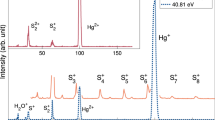Abstract
STUDIES of the near infra-red bands of diatomic sulphur (S2) showed1,2 that they form two systems of bands involving (a) 3IIg—3Δu and (b) 3IIg—3σ+u transitions with 3IIg being the common initial level for both the systems. Bands of the isotopic molecules, 32S 34S and 34S2 (in addition to 32S2), have now been obtained. Vibrational and rotational analyses of these bands confirm the observations of earlier studies2 and show that the emitter of the near infrared bands is the diatomic sulphur molecule. Further, the isotope shifts provide a correct vibrational assignment of the bands in both the systems. The results of these investigations are presented in this communication.
This is a preview of subscription content, access via your institution
Access options
Subscribe to this journal
Receive 51 print issues and online access
$199.00 per year
only $3.90 per issue
Buy this article
- Purchase on Springer Link
- Instant access to full article PDF
Prices may be subject to local taxes which are calculated during checkout
Similar content being viewed by others
References
Meakin, J. E., and Barrow, R. F., Canad. J. Phys., 40, 377 (1962).
Narasimham, N. A., and Sethuraman, V., Proc. Ind. Sci. Congress (1963).
Narasimham, N. A., Curr. Sci., 33, 261 (1964).
Author information
Authors and Affiliations
Rights and permissions
About this article
Cite this article
NARASIMHAM, N., APPARAO, K. Isotope Shifts in the Near Infra-red Bands of Diatomic Sulphur. Nature 210, 1034–1035 (1966). https://doi.org/10.1038/2101034a0
Issue Date:
DOI: https://doi.org/10.1038/2101034a0
Comments
By submitting a comment you agree to abide by our Terms and Community Guidelines. If you find something abusive or that does not comply with our terms or guidelines please flag it as inappropriate.



